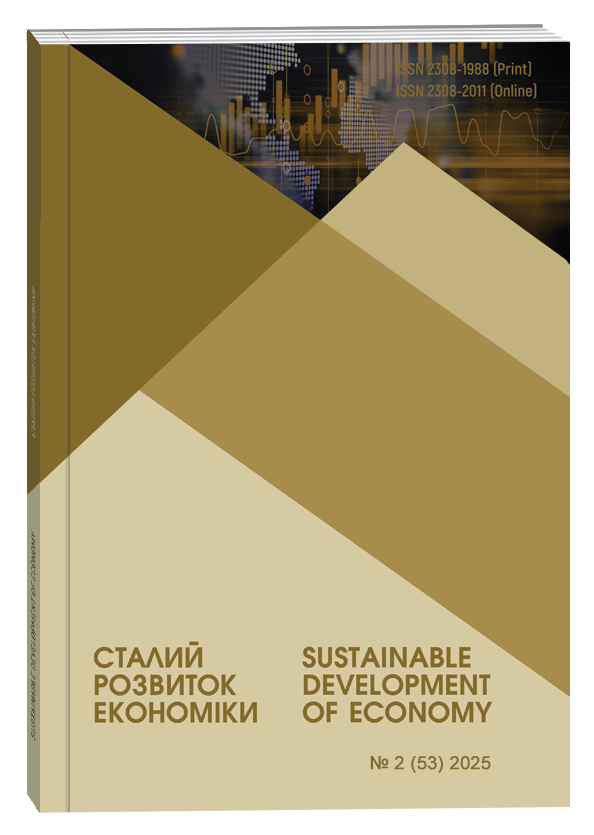SOCIO-ECONOMIC IMPERATIVES OF STATE SUPPORT FOR SECURITY OF HUMAN CAPITAL DEVELOPMENT
Abstract
The article explores the concept of the security-based development of human capital in the context of public funding. It substantiates the existence of a direct relationship between the volume of government investments in key sectors – particularly education, healthcare, and social protection – and the level of human capital development in a country. It is established that systematic and targeted funding contributes to the improvement of indicators such as literacy rate, life expectancy, labor productivity, and the population’s innovative capacity, which collectively form the foundation of a competitive national economy. The experience of countries with a high level of social welfare – such as Sweden, Norway, Denmark, and Singapore – is analyzed, demonstrating the effectiveness of substantial state investments in human capital, as evidenced by sustained socio-economic growth, sustainable development, and high positions in international rankings. At the same time, attention is drawn to the academic debate on defining optimal investment intervals, as both excessive and insufficient funding may lead to adverse outcomes, including inefficient resource use or limited development opportunities in the medium and long term. Taking into account the economic, demographic, and social characteristics of countries, the necessity of establishing investment intervals is substantiated, considering such factors as the state's economic capacity, the age structure of the population, fiscal stability, the efficiency of fund utilization, and social priorities. The article presents analytical conclusions and proposals that may be used in the development of public policy on investment in human capital, aimed at ensuring its sustainable and security-oriented development in the face of contemporary challenges. Further research should focus on developing methodological approaches to optimizing investment volumes in human capital, establishing a system of indicators for assessing funding efficiency, and analyzing cross-national experiences under conditions of global transformations.
References
Ghosh S. Foreign direct investment, female education, capital formation, and economic growth in Japan and South Korea. International Economic Journal. 2019. Vol. 33, No. 3. P. 437–453. DOI: https://doi.org/10.1080/10168737.2019.1600155
Islam I., Kucera D. Beyond macroeconomic stability. Investing in people: extending social security through national social protection floors. In: Investing in people. London : Palgrave Macmillan, 2014. P. 228–259. URL: https://link.springer.com/chapter/10.1057/9781137379252_7
Kim S.-H. Education policy in South Korea: a contemporary model of human capital accumulation? Cogent Economics & Finance. 2017. Vol. 5, No. 1. DOI: https://doi.org/10.1080/23322039.2017.1389804
OECD. Social spending. URL: https://www.oecd.org/en/data/indicators/social-spending.html
Seran S. Investment and quality of human capital in economic development. Journal of Economics and Development Studies. 2018. Vol. 6, No. 1. P. 30–42. DOI: https://doi.org/10.15640/jeds.v6n1a4
United Nations. Millennium Development Goals. URL: https://www.un.org/millenniumgoals/
UNESCO. Education 2030 framework for action. Paris, 2015. URL: https://uis.unesco.org/sites/default/files/documents/education-2030-incheon-framework-for-action-implementation-of-sdg4-2016-en_2.pdf
World Bank. Review of public expenditure and assessment of social assistance programs. 2021. URL: https://documents1.worldbank.org/curated/en/917101631781781565/pdf/Main-Report-FY11-FY20.pdf
World Health Organization. World health statistics 2024: monitoring health for the SDGs, sustainable development goals. Geneva, 2024. URL: https://iris.who.int/bitstream/handle/10665/376869/9789240094703-eng.pdf?sequence=1
Васильченко В. С., Гриненко А. М., Грішнова О. А., Керб Л. П. Управління трудовим потенціалом : навч. посіб. Київ : КНЕУ, 2005. 403 с.
Державний веб-портал бюджету для громадян. URL: https://openbudget.gov.ua/
Дуга С. Людський капітал як фактор конкурентоспроможності національної економіки: аналіз сучасного стану та перспективи розвитку. Економіка та суспільство. 2024. № 70. DOI: https://doi.org/10.32782/2524-0072/2024-70-8
Назарова Г., Назаров Н. Людський капітал: гендерні аспекти формування та регулювання. Сталий розвиток економіки. 2024. № 2(49) С. 49-55. DOI: https://doi.org/10.32782/2308-1988/2024-49-8
Сакун Л., Бутурлим Т., Павлуша Т. Проблеми та перспективи інвестування в людський капітал в умовах воєнного часу. Development Service Industry Management. 2025. № 1, С. 46–52. DOI: https://doi.org/10.31891/dsim-2025-9(6)
Сахненко О. І. Основні види інвестицій в людський капітал. Ефективна економіка. 2015. № 10. URL: http://nbuv.gov.ua/UJRN/efek_2015_10_94
Ghosh S. (2019) Foreign direct investment, female education, capital formation, and economic growth in Japan and South Korea. International Economic Journal. Vol. 33, No. 3. P. 437–453. DOI: https://doi.org/10.1080/10168737.2019.1600155
Islam I., Kucera D. (2014) Beyond macroeconomic stability. Investing in people: extending social security through national social protection floors. In: Investing in people. London : Palgrave Macmillan, P. 228–259. Available at: https://link.springer.com/chapter/10.1057/9781137379252_7
Kim S.-H. (2017) Education policy in South Korea: a contemporary model of human capital accumulation? Cogent Economics & Finance. Vol. 5, No. 1. DOI: https://doi.org/10.1080/23322039.2017.1389804
OECD. Social spending. Available at: https://www.oecd.org/en/data/indicators/social-spending.html
Seran S. (2018) Investment and quality of human capital in economic development. Journal of Economics and Development Studies.. Vol. 6, No. 1. P. 30–42. DOI: https://doi.org/10.15640/jeds.v6n1a4
United Nations. Millennium Development Goals. Available at: https://www.un.org/millenniumgoals/
UNESCO. Education 2030 framework for action. Paris. (2015). Available at: https://uis.unesco.org/sites/default/files/documents/education-2030-incheon-framework-for-action-implementation-of-sdg4-2016-en_2.pdf
World Bank. Review of public expenditure and assessment of social assistance programs. (2021). Available at: https://documents1.worldbank.org/curated/en/917101631781781565/pdf/Main-Report-FY11-FY20.pdf
World Health Organization. World health statistics 2024: monitoring health for the SDGs, sustainable development goals. Geneva. (2024). Available at: https://iris.who.int/bitstream/handle/10665/376869/9789240094703-eng.pdf?sequence=1
Vasylchenko V. S., Hrynenko A. M., Hrishnova O. A., Kerb L. P. (2005) Upravlinnia trudovym potentsialom : navch. posib. Kyiv: KNEU, 403 p.
Derzhavnyi veb-portal biudzhetu dlia hromadian. Available at: https://openbudget.gov.ua/.
Duha S. (2024) Liudskyi kapital yak faktor konkurentospromozhnosti natsionalnoi ekonomiky: analiz suchasnoho stanu ta perspektyvy rozvytku. Ekonomika ta suspilstvo. no. 70. DOI: https://doi.org/10.32782/2524-0072/2024-70-8
Nazarova H., Nazarov N. (2024) Liudskyi kapital: henderni aspekty formuvannia ta rehuliuvannia. Stalyi rozvytok ekonomiky. №2(49) S. 49-55. DOI: https://doi.org/10.32782/2308-1988/2024-49-8
Sakun L., Buturlym T., Pavlusha T. (2025) Problemy ta perspektyvy investuvannia v liudskyi kapital v umovakh voiennoho chasu. Development Service Industry Management. №1, S.46–52. DOI: https://doi.org/10.31891/dsim-2025-9(6)
Sakhnenko O. I. (2015) Osnovni vydy investytsii v liudskyi kapital. Efektyvna ekonomika. no. 10. Available at: http://nbuv.gov.ua/UJRN/efek_2015_10_94


